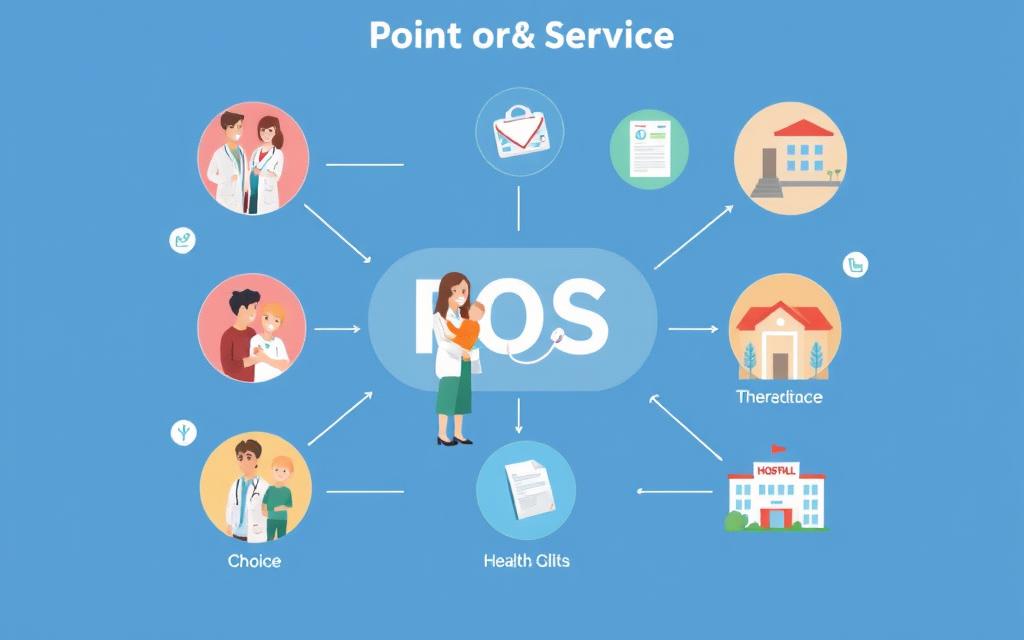adversiment
The U.S. spends more on healthcare than any other developed nation. Americans face a complex landscape of health insurance plans. This guide explores various options to help you make informed decisions about your healthcare coverage.
Understanding key concepts and plan types can help you find the right fit. We’ll explore employer-sponsored plans and government programs like Medicare and Medicaid. This information will help you make sense of insurance jargon.
This guide covers individual and family coverage options. We’ll look at pros and cons of different plan types. You’ll learn about cost considerations and tips for choosing the right policy.
Our goal is to help you navigate the complex healthcare system. With this knowledge, you can make better decisions about your well-being.
Overview of Health Insurance in the USA
Health insurance is vital in the American healthcare system. It protects finances and ensures access to medical services. In the US, it shields people from steep healthcare costs.
Health insurance covers routine check-ups and emergency treatments. It acts as a safety net for policyholders. Without it, medical bills can be overwhelming.

Importance of Health Insurance
Health insurance greatly impacts financial well-being. Without coverage, one illness could wipe out savings and cause debt. It covers doctor visits and hospital stays.
Insurance also provides access to preventive care. This helps people maintain their overall health and wellness.
Key Terminology Explained
Understanding insurance terms is crucial for informed decisions. Premiums are regular payments to maintain coverage. Deductibles are out-of-pocket expenses before insurance kicks in.
Copays are fixed amounts paid for specific services. These include doctor visits or prescription medications.
Types of Health Insurance Coverage
- Employer-sponsored health insurance: Many Americans get coverage through work. Employers often subsidize part of the premiums.
- Individual health insurance: People can buy policies directly from providers or the Health Insurance Marketplace.
- Government-funded programs: Medicare and Medicaid cover the elderly, disabled, and low-income individuals.
Health insurance USA can be complex. Understanding options and terms helps make informed decisions. This knowledge empowers people to choose the right health benefits and insurance providers.
Types of Health Insurance Plans
In the US, people can choose from various health insurance plans. These include employer-sponsored, individual and family, and government programs like Medicare and Medicaid. Each type caters to different healthcare needs and financial situations.
Employer-Sponsored Health Insurance
Many companies offer group health plans to their employees. These plans are often cheaper than individual coverage. Employers usually help pay for premiums.
Eligibility depends on employment status and company size. This type of insurance is a popular choice for many workers.
Individual and Family Health Insurance
People without employer coverage can buy individual and family policies. These are available from insurance providers or through the Health Insurance Marketplace. The Affordable Care Act established this marketplace.
Premiums and coverage vary based on age, location, and health history. These factors affect the cost and benefits of each plan.
Government Programs: Medicare and Medicaid
The government offers healthcare through Medicare and Medicaid. Medicare is for people 65 and older. Medicaid helps low-income individuals and families.
These programs have different eligibility rules and covered services. They provide important healthcare options for specific groups.
Understanding Health insurance USA options is key to making smart choices. It helps people find coverage that fits their health needs and budget.
Health Maintenance Organizations (HMOs)
Health Maintenance Organizations (HMOs) are a popular healthcare coverage option in the United States. HMOs provide comprehensive medical care through a network of pre-selected healthcare providers. These health insurance plans offer a unique approach to managing healthcare needs.
Features of HMOs
HMOs typically feature the following key characteristics:
- Restricted provider network: Patients can only receive care from a designated group of physicians, hospitals, and other healthcare facilities that are part of the HMO’s network.
- Primary care physician (PCP) requirement: Patients must select a PCP who coordinates their overall healthcare and serves as a gatekeeper, controlling access to specialists and other services.
- Prepaid care: HMO members pay a fixed monthly premium, which covers a wide range of preventive and routine healthcare services, as well as hospitalization and emergency care.
Pros and Cons of HMOs
HMOs offer several potential advantages and disadvantages for healthcare coverage in the USA:
| Pros | Cons |
|---|---|
| Lower monthly premiums compared to other plan types Comprehensive coverage for a wide range of services Emphasis on preventive care and disease management | Restricted provider network, limiting choice of doctors and hospitals Requirement to obtain referrals from the PCP to see specialists Potentially longer wait times to see healthcare providers |
HMOs offer unique benefits and challenges for healthcare in the United States. Understanding these features helps individuals choose the right medical plan for their needs. Careful consideration of HMOs can lead to better healthcare decisions and budgeting.
Preferred Provider Organizations (PPOs)
PPOs are a popular health insurance choice. They offer more flexibility than Health Maintenance Organizations (HMOs). PPOs allow access to a wider range of healthcare providers.
Understanding PPO Structure
PPOs have a network of healthcare providers with agreed-upon rates. Policyholders can use in-network or out-of-network providers. Out-of-network care usually costs more out-of-pocket.
Advantages of Choosing PPOs
- Greater flexibility in choosing healthcare providers
- The ability to see specialists without a referral from a primary care physician
- Potentially lower out-of-pocket costs for in-network services
- Access to a wide range of healthcare services and facilities
Disadvantages of PPOs
- Generally higher monthly premiums compared to HMO plans
- Higher out-of-pocket costs for out-of-network services, which can add up quickly
- The need to navigate a complex network of providers and understand the various coverage levels
Choosing between PPO and HMO plans depends on personal needs. Consider your healthcare needs and budget. Insurance providers can help you understand PPO structures and tradeoffs.
This information can guide your decision about health insurance USA. It’s important to find a plan that fits your health benefits needs.
Exclusive Provider Organizations (EPOs)
Exclusive Provider Organizations (EPOs) offer a unique health insurance USA option. They balance cost and flexibility in healthcare coverage. EPOs sit between restrictive HMOs and open PPOs for medical plans.
What Sets EPOs Apart
EPOs have selective provider networks for member care. Unlike HMOs, they don’t require primary care referrals for specialists. EPOs control provider networks, offering lower costs for in-network services.
They often have cheaper out-of-pocket expenses compared to out-of-network providers. This makes EPOs an attractive choice for many insurance seekers.
EPOs vs. Other Plan Types
- Cost-effective: EPOs typically have lower premiums than PPOs, making them an attractive option for those looking to balance healthcare coverage and affordability.
- Flexibility: EPOs offer more flexibility than HMOs by allowing members to see specialists without a referral, although they still maintain network limitations.
- Network Restrictions: Unlike PPOs, which offer a broader network of providers, EPOs have a more limited network, which can be a drawback for those who prefer a wider range of options.
EPOs offer a unique mix of features in health insurance USA. They balance cost, flexibility, and network access. Understanding EPOs can help you choose the best healthcare coverage.
| Plan Type | Network Size | Referrals Required | Out-of-Network Coverage | Typical Premiums |
|---|---|---|---|---|
| HMO | Narrow | Yes | Limited | Lower |
| PPO | Broad | No | Yes | Higher |
| EPO | Selective | No | Limited | Moderate |
Point of Service Plans (POS)
Point of Service (POS) plans blend features of HMOs and PPOs. They offer a unique approach to health insurance in the United States. These plans provide flexibility while maintaining some structure.
How POS Plans Operate
POS plans require you to choose a primary care physician (PCP). Your PCP coordinates your care and refers you to specialists within the network. Unlike HMOs, POS plans allow you to see out-of-network providers at a higher cost.
Benefits and Drawbacks
POS plans let you choose both in-network and out-of-network providers. This is great for those who want to see specialists without referrals. These plans often have lower monthly premiums than PPO plans.
However, out-of-network care can lead to higher out-of-pocket costs. POS plans also require referrals from your PCP before seeing specialists. This extra step may be inconvenient for some people.
POS plans may have a more limited network than PPO plans. Consider your healthcare needs and budget when choosing a plan. Balance the flexibility with potential costs and referral requirements.

“POS plans offer a unique balance between the structure of an HMO and the flexibility of a PPO, making them an appealing option for many health insurance consumers in the United States.”
Health Savings Accounts (HSAs)
Health Savings Accounts (HSAs) are a powerful tool in health insurance. They help people in the United States save for healthcare costs. HSAs offer significant tax benefits too.
Eligibility Criteria for HSAs
To get an HSA, you must have a high-deductible health plan (HDHP). HDHPs have lower monthly premium costs but higher deductibles. You can’t be on Medicare or be someone’s tax dependent.
Contribution Limits and Tax Benefits
HSAs have yearly contribution limits set by the IRS. In 2023, individuals can add $3,850, while families can contribute $7,750. These contributions use pre-tax dollars, giving immediate tax savings.
Unused funds in your HSA roll over to the next year. This allows your account to grow over time. You can use the money for qualifying healthcare coverage.
| Individual Contribution Limit | Family Contribution Limit |
|---|---|
| $3,850 (2023) | $7,750 (2023) |
HSAs help people manage their healthcare costs better. They allow for smart planning of future medical expenses. Plus, you get the perks of tax-free savings.
Marketplace Health Insurance Options
The Affordable Care Act (ACA) has changed health insurance in the United States. It created health insurance marketplaces, or exchanges. These allow people to compare and enroll in various health plans.
Open Enrollment Periods
The health insurance marketplace has an annual open enrollment period. It usually runs from November 1st to December 15th. During this time, people can review options and change their health insurance.
Certain life events may allow for a special enrollment period. These include getting married, having a child, or losing other coverage.
Navigating the Health Insurance Marketplace
HealthCare.gov is the main portal for the federal marketplace. It helps people compare plans and check for subsidies. Many states also have their own marketplaces with extra resources.
When choosing a plan, consider monthly premiums, deductibles, and copayments. Also, look at the network of healthcare providers. Some people may qualify for subsidies to reduce costs.
The marketplace offers various plan options. These include Health Maintenance Organizations (HMOs), Preferred Provider Organizations (PPOs), and Exclusive Provider Organizations (EPOs). Each type has unique features and trade-offs.
Understanding the marketplace helps people make informed decisions about healthcare coverage. It allows them to use the benefits provided by the Affordable Care Act.
Short-Term Health Insurance
Short-term health insurance offers temporary healthcare coverage. These plans differ from standard medical plans in key ways. They provide a unique solution for specific situations.
Differences from Standard Plans
Short-term plans typically offer limited coverage compared to traditional health insurance USA policies. They often exclude pre-existing conditions, preventive care, and essential health benefits. These plans bridge gaps in healthcare coverage during job changes or between employer-sponsored plans.
When to Consider Short-Term Coverage
- Job loss or change in employment status
- Waiting for coverage under a new employer-sponsored plan
- Temporary gap between individual medical plans
- Missed open enrollment periods for health insurance USA
Short-term plans can be more affordable in certain situations. However, it’s crucial to understand their limitations before deciding. Consult an insurance professional to determine if short-term healthcare coverage suits your needs.
| Plan Type | Coverage Length | Deductible Range | Premium Range |
|---|---|---|---|
| Short-Term Health Insurance | Up to 12 months | $1,000 – $10,000 | $50 – $500 per month |
| Standard Health Insurance | 12 months or more | $500 – $5,000 | $200 – $1,000 per month |
Understanding short-term health insurance USA plans is crucial. It helps you make informed decisions about your healthcare coverage. Choose the option that best fits your needs and budget.
Supplementary Health Insurance
Supplementary health insurance is gaining importance in the U.S. healthcare system. These plans add to your main health insurance policy. They offer extra financial protection and access to special services.
Supplemental plans fill gaps in primary health insurance USA coverage. They provide an extra safety net for unexpected medical costs.
Types of Supplemental Plans
Supplementary health insurance comes in various forms. Each type addresses specific healthcare needs. These plans enhance your primary health benefits.
- Dental Insurance: Covers routine check-ups, cleanings, and various dental procedures, ensuring that your oral health is maintained.
- Vision Insurance: Provides coverage for eye exams, prescription glasses, contact lenses, and even corrective surgeries like LASIK.
- Critical Illness Insurance: Offers financial support in the event of a major health crisis, such as a heart attack, stroke, or cancer diagnosis.
Why Consider Supplemental Insurance?
Out-of-pocket healthcare costs can quickly add up. Supplementary insurance providers help protect your finances. These plans manage unexpected medical expenses.
With supplemental insurance, you can access needed care without facing overwhelming costs. It’s an extra layer of protection for your health and wallet.
| Supplemental Plan | Key Benefits | Average Monthly Cost |
|---|---|---|
| Dental Insurance | Covers routine check-ups, cleanings, and dental procedures | $30 – $50 |
| Vision Insurance | Provides coverage for eye exams, glasses, and contact lenses | $15 – $25 |
| Critical Illness Insurance | Offers financial support for major health crises like cancer, heart attacks, and strokes | $25 – $100 |
Assess your healthcare needs carefully. Look into available health insurance USA options. Choose supplementary coverage that fits your primary plan and protects your family.
Cost Considerations in Health Insurance
Understanding health insurance costs in the USA is vital. Monthly premiums and out-of-pocket expenses shape your healthcare coverage’s affordability. These include deductibles and copays.
How Premiums Are Determined
Health insurance premiums depend on age, location, plan choice, and coverage level. Older individuals and those in high-cost areas pay more. Comprehensive plans with lower deductibles often have higher monthly premiums.
Out-of-Pocket Costs Explained
Even with insurance, you may face out-of-pocket costs for medical care. These can include:
- Deductibles: The amount you must pay before your insurance coverage kicks in.
- Copays: A fixed dollar amount you pay for specific services, such as doctor visits or prescription drugs.
- Coinsurance: A percentage of the total cost you’re responsible for after meeting your deductible.
Knowing these costs helps you choose the right health insurance USA plan. It allows you to balance your needs and budget effectively.
| Cost Factor | Description | Impact on Overall Costs |
|---|---|---|
| Premium | The monthly fee paid for health insurance coverage | Higher premiums generally mean lower out-of-pocket costs, but higher overall expenses |
| Deductible | The amount you pay before your insurance coverage begins | Higher deductibles lead to lower premiums but higher out-of-pocket costs when you need care |
| Copay | A fixed dollar amount paid for specific services, such as doctor visits or prescriptions | Lower copays result in higher premiums, but can reduce costs for frequent medical care |
| Coinsurance | A percentage of the total cost you’re responsible for after meeting your deductible | Lower coinsurance rates mean higher premiums, but can provide more financial protection |
“Choosing the right health insurance plan is a balancing act between premium costs and out-of-pocket expenses. Understanding these factors can help you find the best coverage for your budget and healthcare needs.”
How to Choose the Right Health Insurance Plan
Picking the best health insurance plan is vital for proper coverage. Start by checking your healthcare needs. Think about your age, health, and any ongoing medical issues. This helps you find the right coverage level and plan type.
Assessing Your Healthcare Needs
Look at your current and future healthcare needs. Think about your usual medical costs, like doctor visits and medicines. Consider any planned procedures or treatments too.
This helps you understand what coverage you need. You’ll avoid paying for extra services or being underinsured.
Comparing Different Plans
After knowing your needs, explore available health insurance plans. Compare HMOs, PPOs, and EPOs to find what fits your needs and budget.
Check the plan’s deductibles, copays, and out-of-pocket maximums. These can greatly affect your total costs.
Questions to Ask Insurers
Ask the right questions when looking at health insurance plans. Find out if your doctor is in the plan’s network. Ask about coverage limits for specific services.
Check the rules for referrals and prior authorizations. These questions help you understand the plan’s features and if it meets your needs.
FAQ
What is the importance of having health insurance in the United States?
Health insurance protects people from high medical costs in the US. It covers preventive services, doctor visits, and hospitalizations. This coverage ensures financial stability and access to needed medical care.
What are the different types of health insurance coverage available in the US?
The main types are employer-sponsored plans, individual plans, and government programs. These include Medicare and Medicaid. Each type has its own rules, coverage levels, and costs.
How do Health Maintenance Organizations (HMOs) work?
HMOs require members to use a network of designated healthcare providers. They often have lower premiums but more restrictions. HMOs typically need referrals for specialists.
Benefits include lower out-of-pocket costs. Drawbacks may include limited provider choice.
What are the key differences between Preferred Provider Organizations (PPOs) and HMOs?
PPOs offer more flexibility in choosing healthcare providers. They allow both in-network and out-of-network care. PPOs generally have higher premiums but lower out-of-pocket costs for in-network providers.
Unlike HMOs, PPOs don’t require referrals to see specialists.
What is a Health Savings Account (HSA) and how does it work?
An HSA is a tax-advantaged savings account for medical expenses. It’s usually paired with high-deductible health plans. People can contribute pre-tax dollars and withdraw tax-free for healthcare costs.
What is the health insurance marketplace, and how does it work?
The health insurance marketplace is an online platform for comparing and enrolling in plans. It’s also known as the Affordable Care Act (ACA) marketplace. It offers various options and possible subsidies.
When is short-term health insurance an appropriate option?
Short-term health insurance provides temporary coverage for up to 364 days. It’s suitable for gaps in regular coverage. This might include job transitions or waiting for employer-sponsored plans to begin.
What types of supplementary health insurance are available?
Supplementary plans can cover dental, vision, and critical illness. They offer extra protection beyond primary health insurance. These plans address specialized healthcare needs.
How are health insurance premiums determined, and what are the key out-of-pocket costs to consider?
Premiums depend on coverage, insurer, age, location, and medical history. Out-of-pocket costs include deductibles, copayments, and coinsurance. These costs vary across plans and affect overall coverage expenses.
What should I consider when choosing the right health insurance plan?
Assess your healthcare needs and compare plan features and costs. Ask insurers about coverage, provider networks, and out-of-pocket expenses. Careful evaluation helps you choose a plan that fits your budget and health needs.



